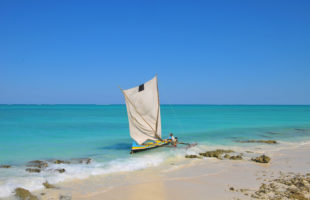Ranomafana:
Ranomafana owes its name to its thermal springs, which constantly pump warm water (in Malagasy rano mafana) into the valley.
Location:

Ranomafana National Park is located between the two regions of Haute Matsiatra and Vatovavy-Fitovinany, about 420 kilometers south-east of the capital Antananarivo. For the journey via the RN7 from the capital, you need about one and a half days by car or bus, connected with a worthwhile stay in the village Ambositra. The non-stop trip to the National Park takes about ten hours, depending on the current condition of the road (usually easy to drive on). Shortly before Alakamisy Ambohimaha turn off RN7 onto RN45 following the signs. This road is also well asphalted, but like all roads in the highlands very curvy. The nearest major city from Ranomafana is Fianarantsoa, a few hours south of the park.
Information about the national park:
Ranomafana is Madagascar’s third-largest national park with an area of almost 410 km² and is home to a wealth of endemic (only here occurring) animals and plants. In 1986 it was the primatologist Dr. Patricia Wright who discovered the golden lemur of bamboo here and worked energetically in the following years together with other scientists to protect the valuable forest area. In 1991, the efforts were rewarded and Ranomafana was officially declared a National Park. In the same year, Patricia Wright founded the now world-famous Centre ValBio on the edge of the park, which has been the starting point for countless scientific research projects in the Ranomafana forest for decades. Centre ValBio also aims to reduce the poverty of the villages bordering the forest, to train people in species conservation, ecotourism, and the environment and to work together for the survival of Ranomafana. The tribe of the Tanala (“those who live in the forest”) is native to this region.
Ranomafana was declared a UNESCO World Heritage Site in 2007. Like almost all national parks in Madagascar, this forest offers several hiking routes. From the easiest, three-hour hike to the extremely difficult 3-day tour, there is something for every hiker and nature lover. You should bring sturdy shoes – the paths are all easily accessible, but wet and since Ranomfana lies in a valley, there are plenty of stairs to climb.

Climate:
The climate is humid-tropical, corresponding to a rainforest. Due to the altitude of approx. 1000 meters it can cool down considerably at night. Even in the dry season, it rains here again and again long and abundantly, and almost nobody manages to visit this national park without a strong rain shower. Waterproof shoes and rain jackets are therefore an absolute must.
Infrastructure:
Due to the humid climate, the camping in Ranomafana is felt by many travelers as not very comfortable – the campground of the park, rustically equipped, lies directly in the rain forest. However, there are a number of nice hotels around the park which are quickly booked up during the high season (end of July to the beginning of September). Reservations well in advance are therefore mandatory. Inside the village, there is a kind of swimming pool where you can have a massage. Alternatively, you can relax in the warm springs that feed the pools. The Park Office is located just a few kilometers from the town on the road that also passes through the village of Ranomafana – here you pay entrance fees and are assigned a local guide.
Fauna & Flora:
With around 110 bird species, 90 amphibians, and around 60 reptile species, this forest offers a wealth of discovery opportunities. Ranomafana is home to the rare Golden Bamboo Lemur (Hapalemur aureus), which can be seen quite well in its family associations in the park with a bit of luck. The brown-white Edward’s Sifaka (Propithecus edwardsi) has also found a home in the tops of the jungle giants. Other lemurs that inhabit this rainforest include the Large Bamboo Lemur (Prolemur simus) – who was thought to be extinct until his re-discovery by Centre ValBio – and its little cousin, the Grey Bamboo Lemur (Hapalemur griseus).

Ranomafana is a hotspot especially for reptile lovers: several magnificent and rare species of chameleons can be found here, including Furcifer balteatus, Calumma oshaughnessyi, Calumma glawi, Calumma parsonii parsonii, Calumma crypticum with its blue legs or the small leaf chameleon Palleon nasus. Who has a good eye can discover the bizarre leaf-tailed gecko Uroplatus phantasticus well camouflaged between old leaves. If you like frogs, you might also think you are in paradise here: Only in a few places, you can photograph so many different, colorful species in leaves, old bamboo canes, and on trees.
The number of insect species is also enormous, especially butterflies and the unique giraffe-necked weevil (Trachelophorus giraffae) can be found here. The nocturnal Moon Moth (Argema mittrei), one of the largest moths in the world, is often seen in Ranomafana in the late evening, and sometimes flies near the hotels. The forests are interspersed with tree ferns and lichens, flowering orchids enchant botanists. This fantastic rainforest offers a high degree of endemism, and new animal and plant species are constantly being discovered.
 MADAMAGAZINE Your Magazine about Madagascar
MADAMAGAZINE Your Magazine about Madagascar




















